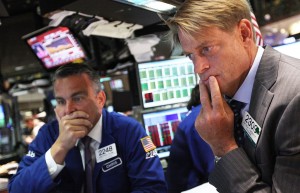Consumer Confidence And The Dipping Dow
It’s been a crazy couple of weeks on Wall Street. First came the bad-ish news: The GDP grew…but not by much. Then came the good-ish news: Congress made an 11th hour deal to raise the debt ceiling and avert default…but it didn’t immediately solidify the country’s AAA credit rating. Just yesterday, the stock market fell, only to make a small comeback. And now today, The Boston Globe gives us this AP market roundup:
Mario Tama / Getty Images
It's been a crazy week on Wall Street, but how it will affect an already complicated picture of consumer confidence--if at all--remains to be seen.
“The Dow plunged nearly 513 points Thursday, its biggest point decline since Oct. 22, 2008. Only three of the 500 stocks in the Standard & Poor’s 500 index had gains. Oil fell by 6 percent. The yield on the two-year Treasury note hit a record low as investors sought out relatively stable investments.”
But in the spirit of this week’s bad-to-worse-to-slightly-better vibe:
“All three major stock indexes are down 10 percent or more from their previous highs, a drop-off that is considered to be a market correction. A drop of 20 percent or more signifies the start of a bear market, an extended period of stock declines.”
These rapid shifts in the macroeconomic landscape are mirrored by big differences in perception on the microeconomic level. Let’s start with a piece in yesterday’s Slate. Annie Lowrey reports that although the Big Three chains–Dollar Tree, Family Dollar, and Dollar General—“posted strong profits in the first quarter of the year,” two of the three didn’t meet their earnings goals. Apparently, people are focused on the essentials, and aren’t able, or willing, to splurge on luxury items–even at the dollar store:
“And the companies’ investor notes report that customers are buying fewer discretionary items, like hand lotion and decorative goods, and more “consumables” and household items, like toilet paper…
…Dollar Tree, for instance, said that it saw its gross profits thinning, ‘a result of the impact of stronger sales of lower-margin consumables, increased promotional markdowns, and higher freight expense.’ In an earnings call, as reported by the [Wall Street] Journal, CEO Rick Dreiling explained that the stores let margins drop because they did not feel comfortable passing price increases onto consumers. ‘We have 228 items that are priced at $1 that we think are incredibly important to our customers that we elected not to take price increases on,” he said. ‘This sounds almost silly, but a $1 item going to $1.15 in our channel is a major change for our customer.'”
That piece stands in stark contrast to another perspective–also published yesterday–in The New York Times:
“…the rich are again buying designer clothing, luxury cars and about anything that catches their fancy. Luxury goods stores, which fared much worse than other retailers in the recession, are more than recovering — they are zooming. Many high-end businesses are even able to mark up, rather than discount, items to attract customers who equate quality with price…
…The luxury category has posted 10 consecutive months of sales increases compared with the year earlier, even as overall consumer spending on categories like furniture and electronics has been tepid, according to the research service MasterCard Advisors SpendingPulse…
What changed? Mostly, the stock market, retailers and analysts said, as well as a good bit of shopping psychology. Even with the sharp drop in stocks over the last week, the Dow Jones is up about 80 percent from its low in March 2009. And with the overall economy nowhere near its recession lows, buying nice, expensive things is back in vogue for people who can afford it.”
So two news organizations focused on two very different microeconomic viewpoints on the same day, of a shaky week, for the market. But let’s bring it closer to home. Last week, the latest Business and Industry Association Consumer Confidence Index was released. NHPR’s Amy Quinton reported:
“36-percent of NH consumers think local businesses will do well financially over the next year.
32-percent think they will experience bad economic times, and another 32-percent believe conditions will be mixed.
Jim Roche, President of the Business and Industry Association, says the results aren’t surprising.
‘I think it reflects the uncertainty in the economy generally, and also the debate raging in Washington over the debt ceiling and the uncertainty related to that.’
The survey also shows that New Hampshire adults are still pessimistic about the national economy, only 26-percent think the country will experience good times financially over the next 12 months.”
So if nothing else, New Hampshire consumers have at least a little more faith in the state’s economy than in the national situation, but not much. And, just like national news coverage of overall market recovery and consumer habits, it’s incredibly confusing. Even for a mixed bag.
